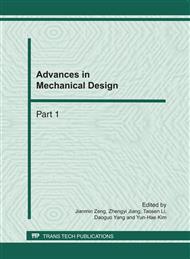p.1244
p.1249
p.1253
p.1257
p.1262
p.1269
p.1273
p.1281
p.1287
Model and Simulation of Three-Section Crossbeam Based on Experimental Data
Abstract:
The modal experiment of the three-section crossbeam was carried out by single-input multi-output method. Identify the stiffness and damping with single-degree-of-freedom identification method. Use ANSYS software APDL programming language and experimental data to establish the finite element model of joint surface of three-section crossbeam. Use modal analysis method analysis the three-section crossbeam which establishes FEM modeling of joint surface. The comparison of the analysis result and experimental result are shown. The FEM result of the three-section crossbeam established FEM modeling of joint surface is basically tally with the experimental result, the modeling methods for joint surface is feasible.
Info:
Periodical:
Pages:
1262-1268
Citation:
Online since:
February 2011
Authors:
Price:
Сopyright:
© 2011 Trans Tech Publications Ltd. All Rights Reserved
Share:
Citation:


